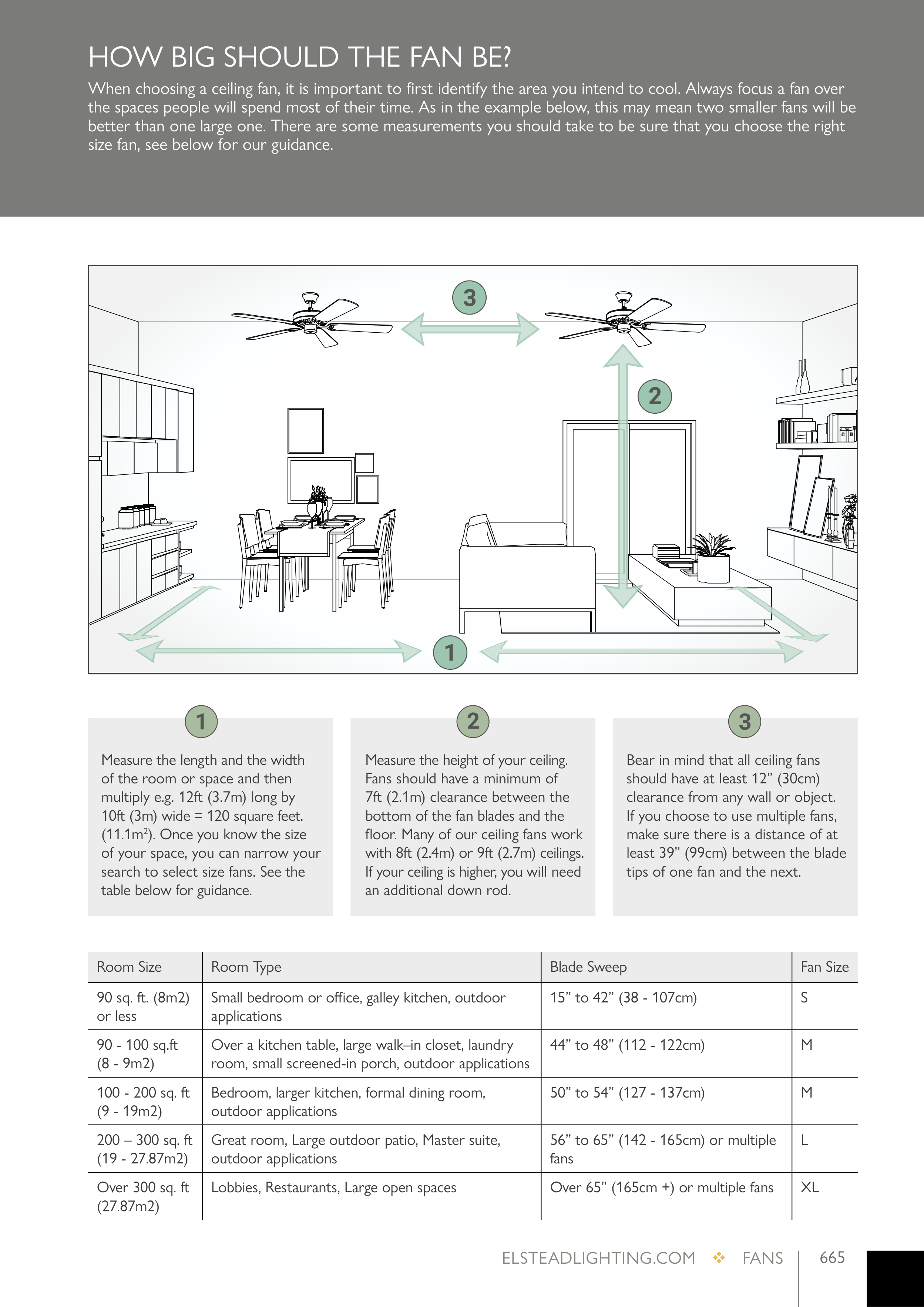ELSTEADLIGHTING.COM FANS
665
HOW BIG SHOULD THE FAN BE?
When choosing a ceiling fan, it is important to first identify the area you intend to cool. Always focus a fan over
the spaces people will spend most of their time. As in the example below, this may mean two smaller fans will be
better than one large one. There are some measurements you should take to be sure that you choose the right
size fan, see below for our guidance.
Measure the length and the width
of the room or space and then
multiply e.g. 12ft (3.7m) long by
10ft (3m) wide = 120 square feet.
(11.1m2). Once you know the size
of your space, you can narrow your
search to select size fans. See the
table below for guidance.
Room Size
Room Type
Blade Sweep
Fan Size
90 sq. ft. (8m2)
or less
Small bedroom or office, galley kitchen, outdoor
applications
15” to 42” (38 - 107cm)
S
90 - 100 sq.ft
(8 - 9m2)
Over a kitchen table, large walk–in closet, laundry
room, small screened-in porch, outdoor applications
44” to 48” (112 - 122cm)
M
100 - 200 sq. ft
(9 - 19m2)
Bedroom, larger kitchen, formal dining room,
outdoor applications
50” to 54” (127 - 137cm)
M
200 – 300 sq. ft
(19 - 27.87m2)
Great room, Large outdoor patio, Master suite,
outdoor applications
56” to 65” (142 - 165cm) or multiple
fans
L
Over 300 sq. ft
(27.87m2)
Lobbies, Restaurants, Large open spaces
Over 65” (165cm +) or multiple fans
XL
Measure the height of your ceiling.
Fans should have a minimum of
7ft (2.1m) clearance between the
bottom of the fan blades and the
floor. Many of our ceiling fans work
with 8ft (2.4m) or 9ft (2.7m) ceilings.
If your ceiling is higher, you will need
an additional down rod.
Bear in mind that all ceiling fans
should have at least 12” (30cm)
clearance from any wall or object.
If you choose to use multiple fans,
make sure there is a distance of at
least 39” (99cm) between the blade
tips of one fan and the next.
SEC 11 - (Interior) Fans.indd 665
SEC 11 - (Interior) Fans.indd 665
12/09/2023 16:48:31
12/09/2023 16:48:31
FANS ELSTEADLIGHTING.COM
664
IS THE FAN FOR INSIDE OR
OUTSIDE?
There are some restrictions on where a ceiling fan can be placed, depending on
how much moisture it will come into contact with. The icons below are used in
this catalogue as a quick visual guide to help you know what fan you need.
WHAT STYLE
DO YOU
WANT?
We have a variety of different
styles and finishes in our
collection, designed to fit all needs.
Our modern ceiling fans add
a clean, understated look to
open spaces. You can choose
something more traditional to
complement rooms with classic,
elegant décor. Or blur the lines
with a transitional ceiling fan that
is simple and sophisticated with
minimal ornamentation.
IP44 (Wet)
IP23 (Damp)
Indoor (Dry)
All of our indoor / dry fans should be kept to areas where they
will not come into contact with water, for example, indoor living
spaces and bedrooms.
Ceiling fans with an IP20 / (Humid) rating can be used in
moderate humidity areas, for example, if you have a room that
has bi-fold doors that integrates with the outdoors when opened.
They cannot withstand direct contact with water.
Ceiling fans with an IP23 / (Damp) rating can be used in high-
humidity areas, like enclosed porches, sunrooms or utility rooms.
They feature water-resistant, durable finishes and incorporate
galvanised undercoating on all metal surfaces to protect against
rusting. Also, their blades are made of either ABS plastic or
sealed wood to ensure longevity against damp conditions.
Ceiling fans with an IP44 (Wet) rating can be used in open areas
with direct exposure to sun, rain or water spray, like pergolas
and open porches. They have highly durable finishes against rain
and snow and include all-weather ABS plastic blades.
(See our selection of outdoor fans in the Exterior Catalogue).
IP20 (Humid)
TOP THINGS TO CONSIDER WHEN CHOOSING
YOUR CEILING FAN.
SEC 11 - (Interior) Fans.indd 664
SEC 11 - (Interior) Fans.indd 664
12/09/2023 16:48:29
12/09/2023 16:48:29


